The seemingly delicate and graceful hummingbirds can display surprising aggression when it comes to defending their territories or resources.
Understanding why hummingbirds attack each other unravels the intricate dynamics of their behaviour and sheds light on the evolutionary strategies that have shaped their survival.
In this guide, we will delve into the reasons behind hummingbird aggression, exploring the motivations and circumstances that drive these tiny birds to engage in territorial disputes and aggressive encounters with one another.

Why Do Hummingbirds Attack Each Other?
Hummingbirds are known for their aggressive behaviours and territorial nature, leading to instances where they may attack each other. Here are some key reasons why hummingbirds engage in such behaviour:
Resource Defense
Hummingbirds fiercely protect their preferred food sources, such as nectar-producing flowers or feeders. When one hummingbird perceives another approaching its food territory, it may attack in an attempt to assert dominance and maintain exclusive access to the valuable resource.
These attacks serve as a way to intimidate and deter potential competitors.
Breeding Competition
During the breeding season, male hummingbirds establish and defend territories to attract potential mates. When a rival male enters their breeding territory, aggression and attacks can occur as they compete for the attention of females.
These confrontations are aimed at establishing dominance and securing breeding rights.
Territory Establishment
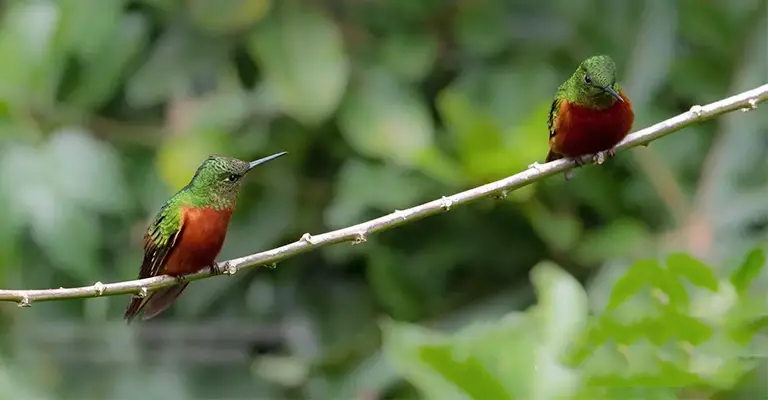
Hummingbirds engage in aggressive behaviours when establishing their territories. They may chase and attack intruding hummingbirds that encroach upon their claimed area.
These aggressive displays serve as a clear warning to other birds to stay away and reinforce their ownership over the territory.
Nest Protection
Hummingbirds fiercely defend their nests and offspring from potential threats. If a hummingbird perceives another bird, including other hummingbirds, larger birds, or predators, approaching their nest, they may launch aggressive attacks to protect their vulnerable chicks.
These attacks aim to drive away any potential danger to ensure the safety and survival of their offspring.
Dominance Hierarchy
Within hummingbird populations, a social hierarchy can develop, and aggressive encounters play a role in establishing and maintaining this hierarchy. Dominant individuals may assert their status through aggressive behaviour, including attacking subordinate hummingbirds.
These interactions help establish clear pecking orders and minimize physical confrontations in the long run.
While hummingbird attacks can be intense and seemingly brutal, they are part of the natural behaviours and strategies that hummingbirds employ to defend resources, establish territories, secure breeding rights, protect nests, and establish social hierarchies.
These aggressive encounters play an essential role in the survival and reproductive success of these remarkable birds.
What Does It Mean When Hummingbirds Are Fighting?
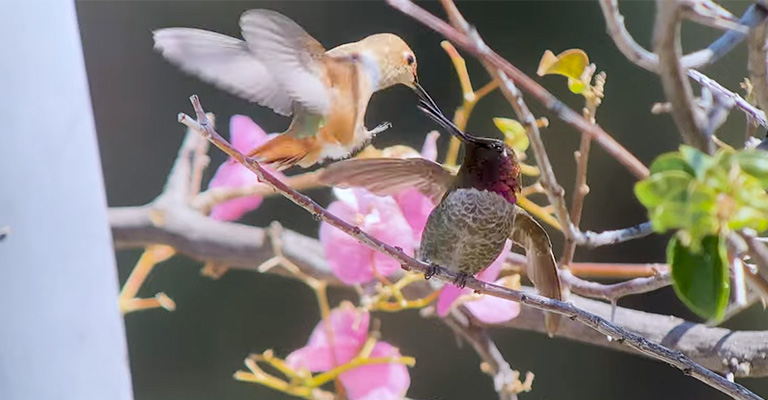
When hummingbirds are fighting, it typically indicates aggressive interactions between individuals. Here are some possible meanings behind their fighting behaviour:
Territory Disputes
Hummingbirds fiercely defend their territories, especially during the breeding season. Fighting between hummingbirds often occurs when one bird encroaches upon another’s territory.
The birds engage in aggressive displays, such as dive-bombing, chasing, or vocalizing, to establish dominance and protect their claimed area.
Resource Competition
Hummingbirds are highly competitive when it comes to food sources, particularly nectar-producing flowers or feeders. Fighting can arise when multiple hummingbirds try to access the same food resource simultaneously.
They engage in aggressive behaviour to ensure exclusive access to food and reduce competition.
Mating Rivalry
During the breeding season, male hummingbirds compete for the attention of females. Fighting can occur between males as they vie for mating opportunities. Aggressive displays, including aerial battles and physical clashes, serve to establish dominance and secure breeding rights.
Nest Protection
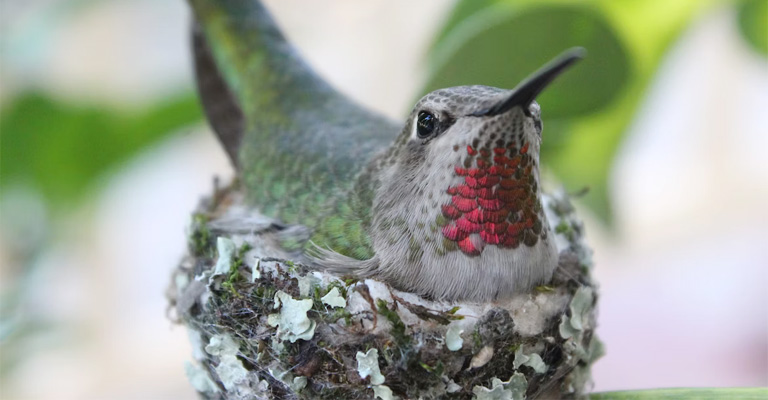
Hummingbirds fiercely protect their nests and offspring from potential threats. If a bird approaches a nest or its immediate vicinity, fights may break out as the defending hummingbird aggressively wards off the intruder to ensure the safety and survival of its vulnerable chicks.
Establishing Hierarchy
Fighting can be a means for hummingbirds to establish a social hierarchy. Dominant individuals may engage in battles with subordinate birds to assert their dominance and maintain their position within the group.
These fights help establish a clear pecking order and minimize future confrontations. When hummingbirds are fighting, it is essential to remember that this behaviour is a natural part of their social interactions and competitive nature.
These fights serve specific purposes, such as defending territories, securing resources, attracting mates, protecting nests, and establishing social hierarchies. They play a vital role in maintaining the balance and survival of hummingbird populations.
Are Hummingbirds Playing Or Fighting When They Chase Each Other?
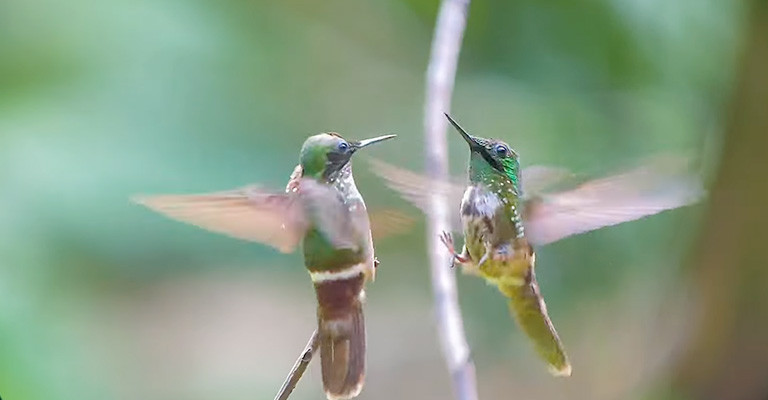
When hummingbirds chase each other, it can be challenging to determine whether they are playing or fighting, as their behaviours can overlap and appear similar. Here are some key factors to consider when observing hummingbirds chasing each other:
Context and Intent
The context in which the chasing behaviour occurs can provide clues. If the birds are in a breeding season or around a food source, it is more likely that the chasing is related to territorial disputes or mating rivalry.
In such cases, the intent is typically more competitive and focused on establishing dominance or securing resources.
Aggressive Displays
Observing aggressive displays during the chase can indicate a higher likelihood of fighting rather than playing. Aggressive displays may include diving, vocalizing, or physical contact between the birds.
If these displays are present, it suggests that the chase is more likely driven by competition or territorial defense.
Prolonged and Intense Chases
If the chase is prolonged, intense, and accompanied by persistent aggression, it is more likely to be a result of fighting rather than playful behaviour.
Playful chases among hummingbirds tend to be shorter and less aggressive, with both birds participating willingly and without escalating aggression.
Repetitive Interactions
If the same individuals engage in repeated chasing behaviour over time, it is more indicative of territorial disputes or ongoing rivalry.
Playful interactions often involve multiple individuals taking turns, with no specific individuals consistently dominating the chase.
Body Language
Pay attention to the body language of the hummingbirds during the chase. If their body posture appears tense, wings are flared, or bills are opened aggressively, it suggests a more confrontational and potentially combative interaction.
While it can be challenging to definitively distinguish between playing and fighting when hummingbirds chase each other, considering the context, aggressive displays, duration, repetitive interactions, and body language can provide insights into the nature of the behaviour.
Keep in mind that chasing behaviour can have varying degrees of competitiveness and aggression, and it may serve different purposes depending on the specific situation and the individuals involved.
9 Tips On Stopping When Hummingbirds Attack Each Other
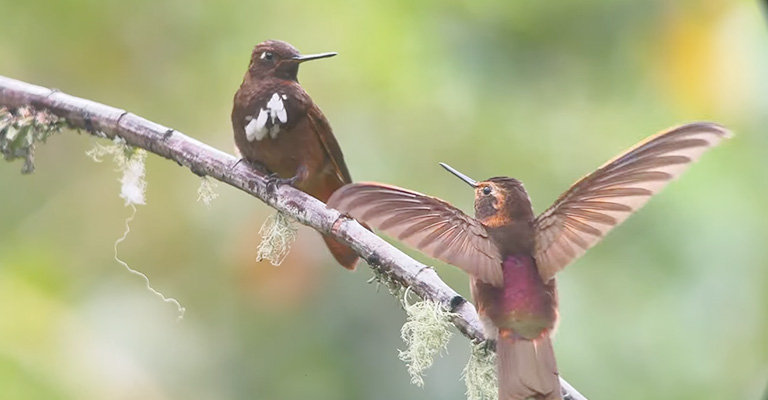
If you’re witnessing aggressive behaviour between hummingbirds, it’s important to take steps to ensure their safety and well-being. Here are nine tips to help mitigate or stop hummingbird attacks:
Increase Feeder Space
Install multiple feeders and spread them out to provide more feeding stations. This can help reduce competition and territorial disputes over a single food source, allowing hummingbirds to feed without constant aggression.
Add Extra Feeders
By offering a greater number of feeders, each with its own ports, it becomes harder for a dominant hummingbird to guard all the feeders simultaneously. This can lessen the chances of aggressive encounters.
Provide Adequate Distance
Ensure that feeders are placed a sufficient distance apart to minimize territorial conflicts. Spacing them at least 10-15 feet apart can help establish separate feeding territories for hummingbirds.
Create Visual Barriers
Use plants, hanging baskets, or other decorative elements to create visual barriers between feeders. These barriers can obstruct the line of sight between competing hummingbirds, reducing direct confrontations.
Increase Food Sources
Plant a variety of nectar-producing flowers in your garden to provide alternative food sources for hummingbirds. A diverse range of flowers will distribute their feeding efforts and potentially reduce aggression around feeders.
Adjust Feeder Placement
Experiment with different feeder placements to discourage dominant hummingbirds from monopolizing a single feeder. Changing the height, orientation, or location of feeders can disrupt established territories and minimize aggressive behaviour.
Monitor and Intervene
Keep a watchful eye on the hummingbird interactions and intervene if the aggression becomes too intense or poses a threat to their safety. Temporary removal of the feeder or creating a distraction, such as spraying a gentle mist of water nearby, can help disperse aggressive birds.
Increase Perching Options
Provide perching spots near feeders or in the vicinity, such as small branches or twigs. Extra perching spaces allow hummingbirds to rest and reduce the need for constant aerial confrontations.
Be Patient
It may take time for hummingbirds to establish a balance and adjust to new feeding arrangements. Patience is key as they work out their territorial boundaries and become accustomed to the increased resources available.
Remember, hummingbird aggression is a natural behaviour driven by competition for limited resources. By implementing these tips, you can create a more harmonious environment and minimize aggressive encounters among hummingbirds.
FAQ
Hummingbirds attack each other primarily to defend their territories and secure exclusive access to vital resources such as food sources and nesting sites. Aggressive behavior is driven by competition for limited resources and the need to establish dominance.
Not all hummingbird species exhibit the same level of aggression. The extent of aggressive behavior varies among species, individuals, and specific circumstances such as breeding season and resource availability.
Hummingbird attacks are primarily driven by aggression rather than play. While their behaviors may sometimes resemble playful interactions, the intent behind the attacks is typically to establish dominance, defend territories, or compete for resources.
Hummingbird attacks are often triggered by territorial disputes, competition for food sources, mating rivalries, or perceived threats to nesting sites. These triggers can elicit aggressive behavior as hummingbirds fiercely protect their territories and ensure their reproductive success.
Hummingbird attacks rarely cause serious harm to the birds involved. Their attacks typically involve aerial displays, chasing, and occasional physical contact. These interactions serve more as displays of dominance or warnings rather than attempts to cause significant physical harm.
Conclusion
The aggression displayed by hummingbirds towards each other is a result of their instinctual drive to protect resources and secure their survival.
Territorial disputes, competition for food sources, mating rivalries, nest protection, and the establishment of social hierarchies are some of the factors that contribute to hummingbird attacks.
While it may seem surprising to witness these aerial acrobats engaged in aggressive behavior, understanding the underlying reasons helps us appreciate the complexity of their behaviors and the adaptive strategies they have developed over time.
As we observe hummingbirds in their natural habitats, let us marvel at the resilience and tenacity that drive their territorial battles, a testament to their determination to thrive in their dynamic and competitive environments.